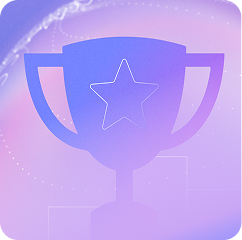
// Recruitment Technology
Migrating from JobAdder to Atlas in 2025: A Smooth Transition Guide
09/07/2025
17 MIN
Planning to migrate from JobAdder? This guide simplifies the transition process of migrating from JobAdder. Learn how to plan, choose the right software, prepare your data, and execute the move. We’ll also highlight benefits and common pitfalls to avoid.
Key takeaways for migrating from JobAdder
- Effective planning, including initial data assessment and setting clear objectives, is critical for a successful migration from JobAdder to a new recruitment ATS like Atlas.
- Selecting the right AI recruitment ATS with advanced features such as automation and comprehensive reporting is essential for improving recruitment processes and overall efficiency.
- Post-migration best practices, including team training and regular data hygiene, play a significant role in ensuring the successful adoption of the new system and enhancing candidate experience.
Planning your data migration
Effective planning is the foundation of any successful data migration project. It helps you avoid costly errors and ensures a smooth, disruption-free transition. A clear, structured plan reduces risk, minimises downtime, and ensures all essential data is properly accounted for.
Without careful preparation, agencies can face unexpected delays and interruptions that impact day-to-day operations. Start by carrying out a thorough data assessment.
Review your current database to identify key information and ensure records are accurate and up to date — this will make the migration process far more straightforward. Next, set clear objectives for your migration. Defining goals such as streamlining your recruitment workflows or improving data quality will keep your project focused and help deliver long-term value.
Atlas stands out as a top choice for agency recruiters looking to move away from JobAdder. Designed as an AI-first platform, it offers advanced automation and intelligent tools that help recruiters work more efficiently and stay ahead in a competitive market.
Initial data assessment
The initial data assessment is a crucial step in migrating from JobAdder. By thoroughly analysing your current database, you can pinpoint the essential data that needs to be carried over to your new system.
This step ensures that only accurate, relevant information is migrated, helping to avoid unnecessary clutter and potential issues down the line. Incomplete or outdated data can create serious gaps in your recruitment processes after the switch, so it’s vital to get this right from the start.
Carrying out a pre-migration audit can also help highlight any structural differences in your data that might cause complications while migrating from JobAdder. Spotting these challenges early on means you can put strategies in place to reduce risks and ensure a smoother, more confident transition to your new ATS.
Setting clear objectives
Clear objectives are key to ensuring a smooth transition from JobAdder. Setting goals such as improving recruitment workflows and enhancing data management helps keep your migration focused and measurable, laying the groundwork for long-term success.
Moving from JobAdder to a more advanced AI-powered CRM, like Atlas, can also give you greater data transparency and control across the entire recruitment journey. By clearly defining your priorities, you can target outcomes such as increased efficiency, stronger team performance, and a better experience for both candidates and clients.
Choosing the right recruitment ATS
Choosing the right recruitment ATS is crucial for the operational efficiency and long-term success of your agency. The best recruitment software streamlines your processes, making it easier to find top talent and manage your entire database confidently. With its AI-driven capabilities, Atlas stands out as an excellent solution for agency recruiters, particularly for those looking to move beyond tools like JobAdder or other legacy systems.
When evaluating new platforms, focus on options that offer advanced features beyond what you’re used to. Look for recruitment CRM solutions that deliver strong automation, detailed reporting, and robust candidate data management. These tools are essential for improving efficiency and enhancing the candidate and client experience.
Key features to prioritise in a new ATS include comprehensive reporting, powerful automation, and specialised tools tailored to different types of recruitment. Atlas excels in all of these areas, offering a modern, disruptive ATS designed to make admin-heavy processes a thing of the past.
Key features to look for in a new ATS
Identify the essential features you need in a new recruitment ATS to truly enhance your processes. Comprehensive reporting helps you analyse performance and make more informed, data-driven decisions.
Meanwhile, automation tools take care of repetitive admin tasks, freeing up your team to focus on strategic, high-value activities that drive placements and strengthen client relationships. At its core, your new ATS should be designed to optimise every stage of the recruitment journey.
It’s also important to consider your agency’s specific needs. Different types of recruitment — for example, temp versus perm — require tools tailored to their unique workflows.
Atlas delivers on this by offering specialised, flexible features that support a wide range of recruitment models, helping agencies operate more effectively and stay ahead of the competition.
All the right recruitment features with none of the unwanted bloat. Try Atlas today >>
Preparing your data for migration
Preparing your data properly is key to smoothly migrating from JobAdder. Cleansing your candidate data before moving ensures a simpler process and protects the integrity of your database. Ongoing monitoring after migration is equally important, helping to maintain data quality and quickly identify any discrepancies in your new system.
Start by cleaning up your candidate data. Remove outdated information and inactive profiles to improve the overall quality of your database, including up-to-date contact details. This step not only makes migration easier but also boosts operational efficiency once you’re up and running on your new ATS.
Additionally, consider data enrichment to add valuable context to candidate profiles — such as updated skills or recent placements — to support a stronger, more informed recruitment process.
Cleansing candidate data
Cleansing candidate data before migration is essential for maintaining data integrity and supporting smooth, efficient operations. To improve the quality of your database, consider these key steps:
- Remove outdated candidate information and inactive profiles.
- Use data profiling tools to analyse your source data and spot inconsistencies.
- Validate and clean all records thoroughly before migration.
Keeping your database clean and accurate helps improve your overall recruitment processes and supports better decision-making across the business. By ensuring only relevant, up-to-date candidate data is migrated, you can avoid potential issues down the line and make your new ATS work harder for your team from day one.
Executing the migration process
Executing the migration process successfully requires a clear, step-by-step approach to ensure a smooth transition. Key considerations include:
- Begin with detailed planning as the first phase of your data migration.
- Check CV and resume accuracy to maintain data integrity.
- Most migrations take around two to three weeks to complete.
- A full cutover often happens over a weekend to minimise disruption.
Start by following the Extract, Load, and Transform (ELT) process. This involves connecting your new database to a data lake and transforming the data in real time to ensure accuracy and consistency.
Data security is critical throughout migration. Use robust encryption methods and ensure full compliance with regulations such as GDPR to protect sensitive candidate and client information. Taking these steps helps you transition confidently, with minimal risk to your operations.
Extract, load, and transform (ELT) process
The ELT (Extract, Load, and Transform) process involves connecting your new database to a data lake and transforming data in real time. This approach helps ensure your migration is both accurate and well-integrated from the start.
Real-time monitoring during the migration is essential, as it allows you to quickly detect and resolve any issues before they become bigger problems. Running test migrations is another valuable step. These dry runs help uncover potential failures early, giving you the chance to correct them before your final migration.
Continuous monitoring and proactive maintenance throughout the process ensure that any unexpected issues are addressed swiftly, making for a smoother, more confident transition to your new ATS.
Ensuring data security
Data security during migration is absolutely paramount. Implementing strong encryption methods helps ensure compliance with GDPR and other data protection regulations, significantly strengthening the protection of sensitive candidate and client information.
Staying compliant not only helps you avoid potential legal issues but also maintains the trust you’ve built with your candidates and clients — something no agency can afford to compromise.
By prioritising data security at every stage, you can move to your new recruitment ATS with confidence, knowing your data is secure and your reputation protected.
Post-migration best practices
After migration, it’s essential to set clear goals and best practices to measure the success of the project and keep expectations aligned across the business. A modern applicant tracking system (ATS) can help you maintain strong data hygiene through features like CV parsing, streamlined candidate sourcing, and intuitive dashboards.
Equally important is training your team on the new system to ensure they feel confident and can use it effectively from day one. Regular data hygiene practices will also help keep your recruitment database accurate and up to date, supporting better decision-making and boosting overall efficiency across your agency.
Training your team
Key strategies for successful system adoption include:
- Providing hands-on training to build team confidence and ensure everyone can use the new system effectively.
- Making use of online resources and tutorials to support ongoing learning and help your team adapt over time.
- Involving end users throughout the migration process to avoid application errors and prevent inefficiencies once the system is live.
Be sure to include training as a core part of your project plan, so all team members feel comfortable and empowered to make the most of the new system’s features. This approach helps streamline your recruitment processes and boosts overall productivity across the agency.
Looking for full migration support and an ATS to meet all your needs? Tell us all about it >>
Regular data hygiene
Establishing a routine data review schedule is key to spotting outdated or irrelevant information that should be removed from your database. Using automated tools can also help you quickly identify and eliminate duplicate records, saving valuable time and effort.
Automation ensures your data management practices stay consistent, reducing manual errors and keeping your database in top shape. Regular data cleaning improves accuracy, speeds up time to hire, and enhances overall database quality — all of which help your recruiters work more efficiently and deliver a better experience to both candidates and clients.
Benefits of migrating from JobAdder
Migrating from JobAdder to a more advanced ATS like Atlas can unlock huge benefits for your agency. By setting clear goals from the start, you’ll improve recruitment efficiency, deliver a better candidate experience, and have a clear way to measure the success of your move.
Atlas is built specifically for agency recruiters who want a modern, admin-free approach to recruitment. Making the switch from JobAdder doesn’t just mean smoother processes — it means empowering your team to work faster, focus on relationships, and ultimately deliver better results for your clients and candidates.
Improved recruitment processes
Setting clear objectives for your migration can make a huge difference to how your agency works day-to-day. Features like automation, in-depth reporting, and strong candidate data management aren’t just nice extras — they’re essential for creating smoother, more efficient workflows.
Moving from JobAdder to a more advanced CRM helps you take control of your data and simplify recruitment operations across the board. Better workflows and stronger data management mean a much-improved business development process, making it easier to source great talent and keep them engaged throughout the process.
Better candidate experience
Stronger data management and regular data hygiene go a long way in boosting candidate engagement. Introducing features like automation and detailed reporting in your new CRM makes it much easier to source top talent and deliver a smoother, more personalised experience.
It’s just as important to make sure your team is fully trained and confident using the new system and workflows. When everyone knows how to get the most out of the platform, you’ll see better engagement and stronger results across the board. Keeping your database accurate and up to date means you can offer a higher-quality experience to both candidates and clients.
Migrate to an admin-free ATS that lets you focus on relationships, not the paperwork. Try Atlas >>
Common migration challenges and how to overcome them
Data migration can come with its fair share of challenges for recruitment agencies, but with the right approach, they’re all manageable. One of the biggest hurdles is dealing with data quality issues, such as:
- Inaccurate or incomplete records that can seriously affect how well your new system works.
- The need for regular data audits to keep everything in check.
- Ongoing cleansing practices to make sure your data stays accurate and reliable.
Unexpected failures during migration can also be a risk. Taking a phased approach helps you tackle these issues bit by bit, so you can spot and fix problems early on without disrupting your entire operation. This steady, methodical method means your team can keep working smoothly while you make the transition.
Handling data quality issues
Data quality issues — like inaccurate or incomplete records — are some of the biggest challenges recruitment agencies face during migration. Regular data audits and proper data cleansing are key to tackling these problems. This means carefully reviewing and verifying historical data to make sure only accurate, relevant information makes it into your new system.
It’s also important to remove any duplicate entries to keep your candidate records clean and reliable. By sorting out these data quality issues early on, you’ll set yourself up for a much smoother transition and ensure your recruitment processes run more effectively once you’re live on the new platform.
Managing unexpected failures
Managing unexpected failures during migration can be tricky, but taking a phased approach helps reduce these risks. This method allows you to:
- Spot and fix issues gradually, keeping disruption to a minimum.
- Reduce the chance of major failures along the way.
- Tackle problems in smaller, manageable steps rather than all at once.
By breaking the process into phases, you make the transition much smoother and avoid widespread problems that could impact your team’s work. This careful, step-by-step strategy also helps protect your data and ensures everything stays on track throughout the migration.
Migrating to Atlas as your recruitment software
Step 1: Requesting and receiving your JobAdder export
We begin by obtaining your data from JobAdder. This usually comes in the form of CSV exports or a full database backup. Delivery is often via direct download or FTP, depending on how your account is set up.
Once you receive access credentials or download links, pass them along to our team. We handle everything from there, ensuring your data is transferred securely and intact.
Step 2: Organizing your data for review
We upload your JobAdder data into Amazon Redshift, a robust environment that lets us examine everything in detail. Candidate profiles, job postings, communication logs, and company records are unpacked and arranged into clean tables.
This organization phase allows us to analyze how your data was structured in JobAdder and prepares it for mapping and transformation.
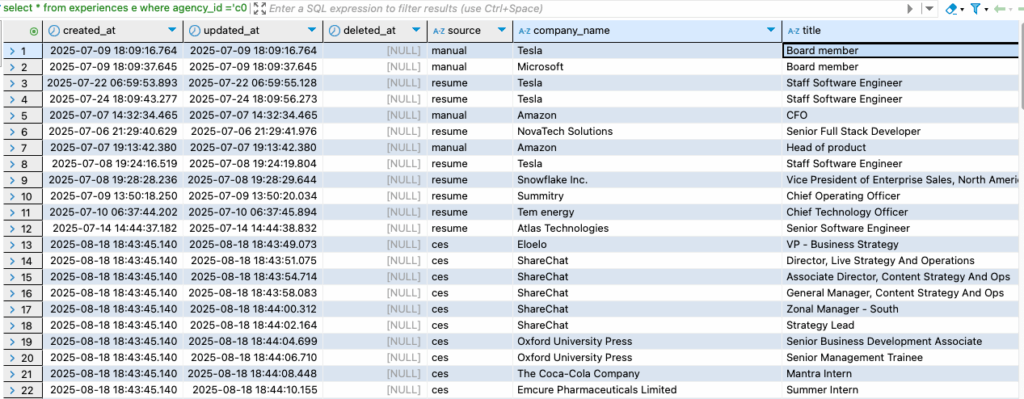
Step 3: Mapping JobAdder fields to Atlas
You’ll use our Migration Dashboard to review your data and align fields from JobAdder to Atlas. Our team provides suggestions for how your current fields should translate. Whether it’s mapping candidate stages, source tags, or custom fields, we guide you every step of the way.
You’ll be able to edit and confirm these mappings directly in the tool. Any ambiguous or inconsistent entries are flagged for discussion, and we track all updates in a shared workspace.
Step 4: Transforming and cleaning your dataset
Once field mappings are finalized, we start transforming your data. Using DBT, we reformat fields, resolve inconsistencies, apply default values, and deduplicate records. Every step is version-controlled and visible.
Automation accelerates repetitive tasks like timestamp normalization and field standardization, while our engineers keep an eye on exceptions or edge cases.
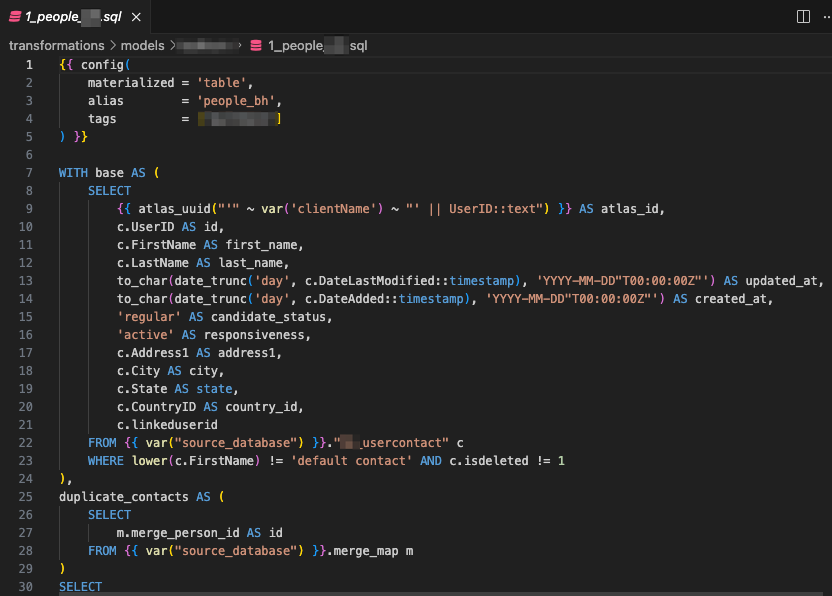
Step 5: Testing for quality and consistency
Before anything goes live, your data goes through a battery of automated QA tests. Each table is checked for field completeness, data types, duplication, and structural consistency.
In parallel, we use AI-based validation to detect less obvious issues like conflicting records or unusual data patterns. This testing phase ensures your data is accurate and production-ready.
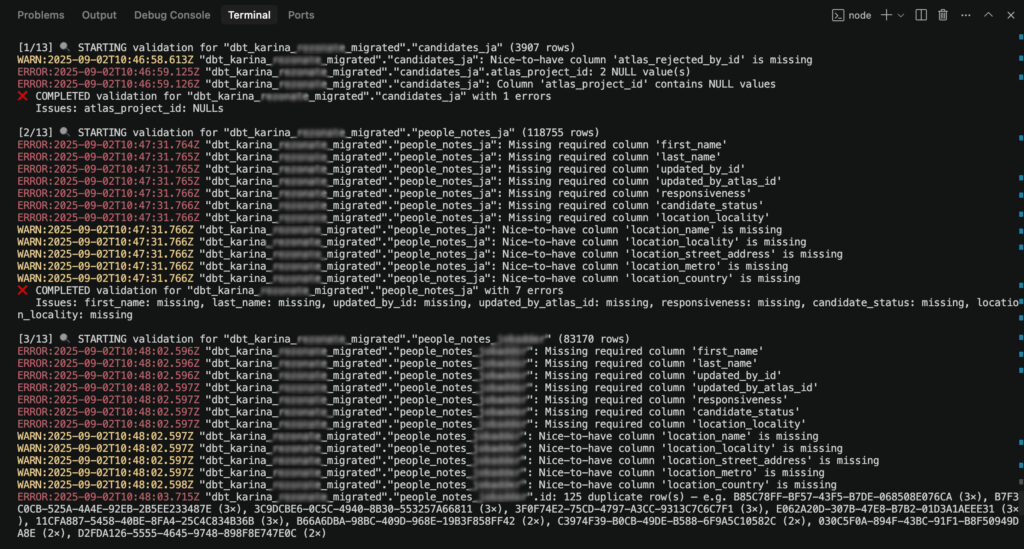
Step 6: Reviewing in a staging version of Atlas
Next, we load your data into a staging environment that matches the live Atlas platform. You and your team can verify everything using a structured checklist we provide. You’ll review candidate data, job records, and files to make sure all content appears correctly.
We collect feedback through Notion and keep you updated with daily progress summaries so nothing slips through the cracks.
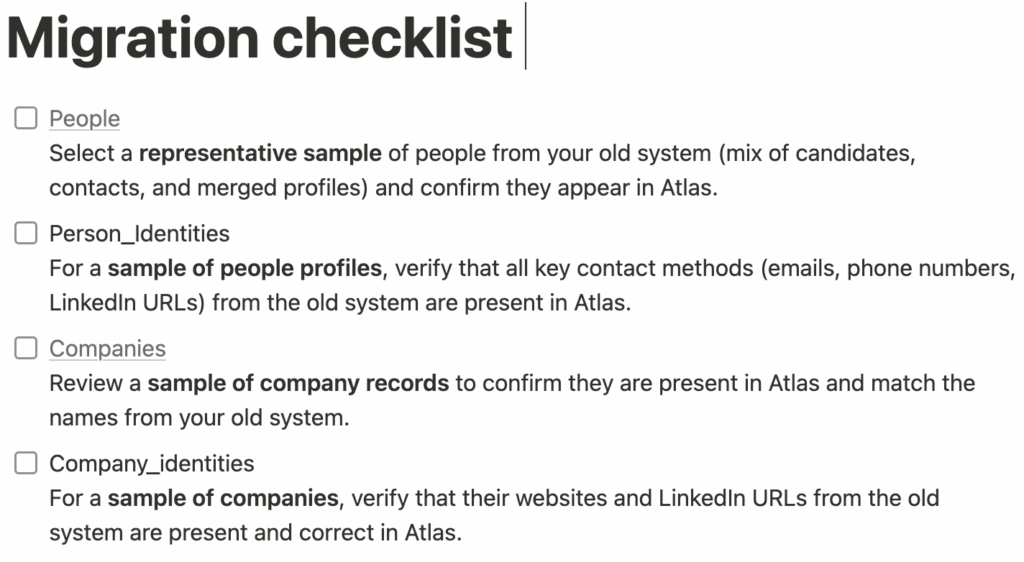
Step 7: Going live with Atlas
Once staging is approved, your data is migrated to the live version of Atlas. If you’re already using the platform, we merge your new data carefully into the existing setup. If you’re starting fresh, the staging instance becomes your production system.
We complete indexing to ensure all records are instantly searchable. All files and documents are linked to the correct records, and your team is ready to hit the ground running with full access.
Your JobAdder migration is now complete with all historical data, files, and workflows seamlessly transitioned into Atlas.
Embrace the change, and let Atlas take your recruitment to new heights. Try it for free >>
Frequently Asked Questions (FAQ) about migrating from JobAdder to a new applicant tracking system (ATS)
The first phase of any data migration is planning, and it’s absolutely crucial. This stage sets the foundation for a smooth, successful migration by clearly outlining your objectives, timelines, and the resources you’ll need. Getting this right helps you avoid potential issues further down the line and keeps the entire project on track from the very start.
Carrying out an initial data assessment is a vital part of the migration process. It allows you to analyse and verify the accuracy and relevance of your key data before moving it across. This step helps ensure a smooth transition, minimises errors, and sets you up for success with your new system.
The ELT process involves connecting your new database to a data lake and transforming the data as it’s loaded. This approach allows for real-time analysis and insights, making it much easier to understand and use your data straight away. Streamlining data integration and processing helps boost overall efficiency and keeps everything running smoothly.
Atlas keeps your data secure throughout the migration process by using strict encryption protocols and fully complying with GDPR and other data protection regulations. This approach helps protect sensitive information every step of the way, giving you peace of mind during the transition.
One of the biggest challenges in data migration is making sure your data is high quality, especially when it comes to inaccurate or incomplete records. Paying close attention to this is crucial to avoid setbacks and ensure everything runs smoothly during the migration.


